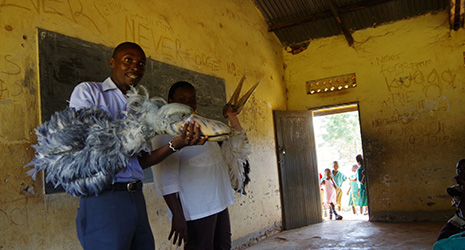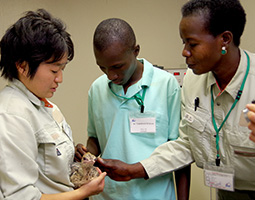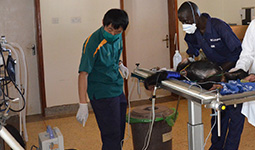April 2020
Love of Animals Connects Japan and Uganda

Zoos in Yokohama have contributed to the conservation of wildlife in Uganda through support for its zoos.
The Republic of Uganda is a landlocked country with a rich natural environment, said to be home to the largest number of animal species on the African continent. In recent years, however, much of this wildlife has come under threat due to deforestation and poaching.
In response to this situation, the Uganda Wildlife Conservation Education Centre (UWEC) on the shores of Lake Victoria conducts activities such as wildlife conservation and conservation education. On a 29-hectare site, UWEC breeds and exhibits some fifty animal species, including giraffes, elephants and chimpanzees. As well as attracting some 300,000 visitors annually, the Centre is a hub for captive breeding and wildlife rescue, and provides conservation education to the community. From 2008 to 2017 the Yokohama Greenery Foundation implemented the Uganda Wildlife Conservation Project as a JICA (Japan International Cooperation Agency) Partnership Program for Grassroots Cooperation in Technology in order to support these activities.
The project grew out of the 4th Tokyo International Conference on African Development (TICAD IV) held in Yokohama in 2008. The idea of a project relating to wildlife had been aired as a potential project for international cooperation in Africa prior to the conference in Yokohama.
“Around that time, a staff member of the Foundation was working on the launch of eco-tours at Kalinzu forest in Western Uganda as a Japan Overseas Cooperation Volunteer. Therefore, Uganda was a familiar country to zoos in Yokohama, and since the UWEC is a comparatively advanced zoo among African nations, city officials went to survey the site and reported the technical expertise possessed by zoos in Yokohama to UWEC. The project resulted from the realization that Japanese zoos could contribute to the conservation of local wildlife,” says Nagakura Kasumi, who has been involved in the project since 2011, including in the capacity of project manager.
The project was implemented mainly by three zoos managed by the Yokohama Greenery Foundation (Yokohama, Nogeyama and Kanazawa Zoological Gardens) and the Preservation and Research Center, the City of Yokohama, a research facility in Yokohama. Specifically, the project accepted trainees from Uganda in the fields of “veterinary medicine,” “animal husbandry,” “education” and “zoo management,” dispatched experts from Yokohama, and provided the necessary materials.

In the veterinary field, for example, medical treatment materials were provided to ensure that animals being bred or protected were kept healthy. Such materials included surgical drills used for bone fracture surgery, endoscopes that determine the sex of birds and ultrasonic scalers for dental treatment. Local staff were trained in the use of these materials by Japanese experts.

The management divisions of the zoos helped strengthen the management of UWEC. As part of this initiative, from 2014 CEO and managerial staff of UWEC were invited to a zoo in Yokohama to attend a training program in zoo management.
“The training covered things such as the custom of staff assembling each morning for the morning meeting and communicating to everyone the work to be done that day, and how when anything happened in the zoo, the staff liaised with each other by radio wirelessly. During their stay in Yokohama they also learned that staff in charge of husbandry and education in Yokohama collaborate on an equal footing. When CEO introduced such activities into UWEC, it quickly led to active personnel exchange and information sharing beyond the boundaries that had previously separated staff in charge of husbandry and education, resulting in smoother communication at the site,” says Nagakura.
This steady cooperative relationship has paid off, with staff at UWEC now proposing new ideas. One such idea is a “Children’s Zoo.”
“Inspired by the Japanese zoo, the staff started thinking that they would like to create a place where Ugandan children can learn by interacting with animals. When the zoo partially opened in 2017 they sent photos. I was deeply moved to see how happy the children and UWEC staff looked.”
In recognition of its efforts, in 2015 UWEC was certified as an official government agency, ensuring its stable operation. In addition, it won various awards, including the Best Conservation Institute award in Uganda and the Pan-African Association of Zoos and Aquaria (PAAZA) Chairman’s award.

“As a result of this project, Ugandan people have been able to develop human resources that can discover and solve issues on their own in a way that is appropriate for Uganda and ensures that UWEC can continue to play its role. We too learned a great deal. We will continue to use the experience gained through the project to conserve wildlife.”

